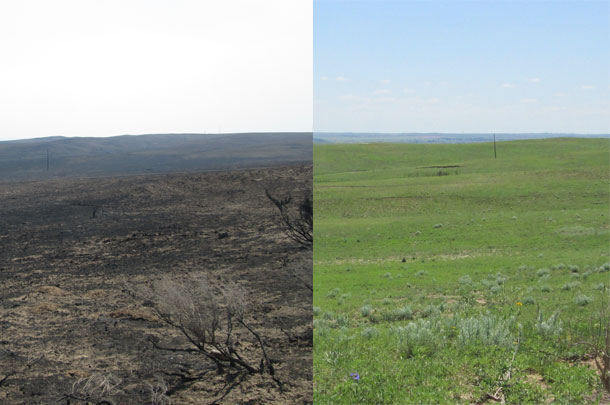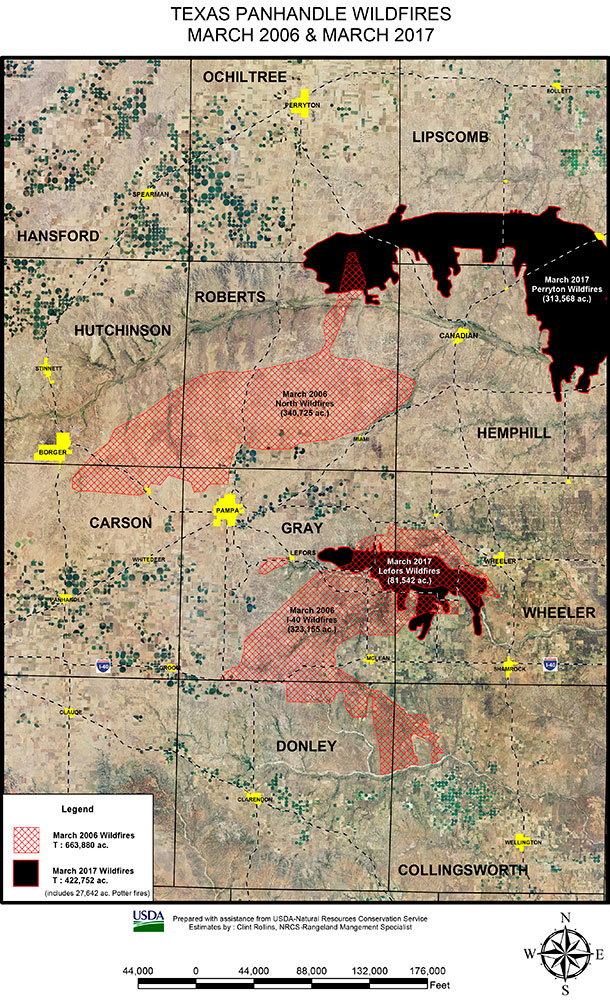Darren Richardson, NRCS assistant state conservationist for field operations in Lubbock, said, “We have taken a total of 46 applications for EQIP recovery and we expect to receive more.”
NRCS professional resource conservationists are assisting producers to address loss of vegetation and an increased risk of soil loss due to erosion by wind and water. Richardson said NRCS is helping producers with practices for grazing deferment, cross fencing and water development that are effective post-fire strategies to help reduce erosion.
Thomas Hunt, district conservationist in Canadian, talked to more than 100 people during meetings and in one-on-one conversations following the fires. “We wanted to help as much as we could,” Hunt said. “NRCS and FSA have worked closely together in this recovery effort. I provided guidance and understanding on what to look for on damaged fences and covered standards and specifications for rebuilding fences. We have also talked extensively about grassland health and what it will take to help the land recover.”
The Big Bull Ranch in Hemphill County, managed by Wes and Crystal Klein, was one of many ranches severely impacted by the fires, with a 100 percent loss of vegetation burned on an estimated 9,000 acres, except for their ranch headquarters and home site.

With the devastation the wildfires brought in so many central states, the Kleins consider themselves more fortunate than some, even though they lost several head of cattle and every acre of grass was burned off the ranch.
Wes Klein said, “We attended the informational meeting that was held in Canadian for affected landowners shortly after the fires occurred. Thomas discussed the programs that would be available due to the fire.
“The assistance available during this devastation will help us out immensely, so much so, that it will enable us to make it financially in order to operate another year,” Klein said. “Without these opportunities, we would not be able to financially survive the hardships that the fire has brought.”
NRCS Rangeland Management Specialist Stan Bradbury from Lubbock said, “The special funding for wildfire assistance through EQIP is helping many ranchers like the Kleins. The shock of charred land can be scary in the aftermath of a wildfire, but Mother Nature has a way of healing herself, and that’s what we are here for.”
Bradbury added that many landowners may be left with the fear that vegetation will not return unless it is reseeded. Even though the initial appearance of the land may look barren, in most cases native plants evolved with fire and are still alive. They can recover with an NRCS management plan.
Click on the image above to view in more detail.
In the development of a management plan, NRCS looks at the factors that affect recovery time, which include types of plants and their adaptation to fire, fire intensity, precipitation (before and after the fire), soil type, previous history of grazing and fire, presence of weeds (competition), season of fire and management after the fire.
Management prior to wildfire will affect recovery time. Plants that had a healthy root system at the time of the burn will recover the quickest. A flush of weeds could be expected the first season after a wildfire. However, these may be plants that benefit wildlife and typically within two years following a wildfire, will decline as grasses increase. The key point is to identify the weeds, understand their life cycle, evaluate their impact on recovery and then make a decision regarding weed control.
“The burned vegetation may still provide some protection from soil movement due to remaining plant roots and plant parts,” Bradbury said. “Instances where erosion could occur include areas where active erosion occurred prior to the wildfire, on very steep slopes, in very sandy soils and along drainages until the vegetation recovers.”
For further assistance in evaluating your land and planning practices to address concerns following a wildfire, contact your local NRCS or Soil and Water Conservation District, or visit the Texas NRCS website. ![]()
Quenna Terry is an NRCS public affairs specialist.
PHOTOS 1 & 2: On the left, photo depicts rangeland burned on Bull Ranch March 6, 2017 – near Goettsche Lake in the Texas Panhandle. On the right, rangeland begins to recover on Bull Ranch April 26, 2017.
PHOTO 3: This NRCS map depicts areas in the Texas Panhandle that burned on March 6 in 2006 and 2017. Photos courtesy of NRCS.







